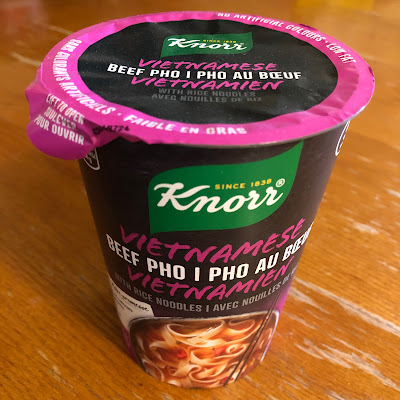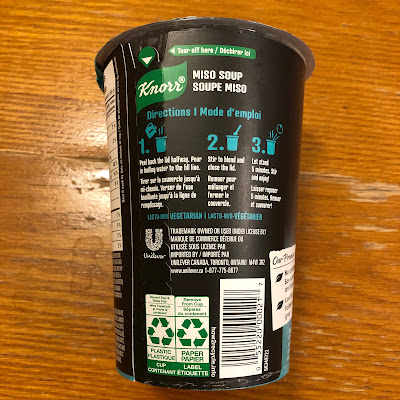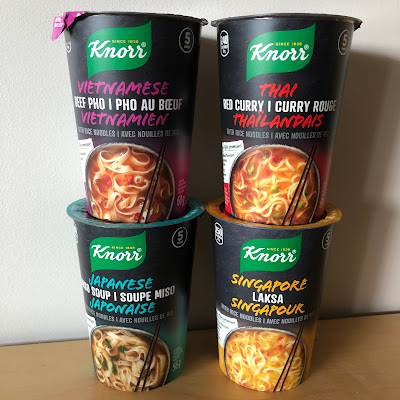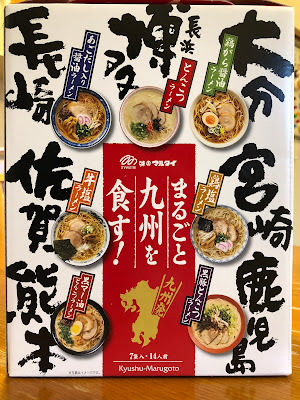Knorr Noodle Cups - Singapore Laksa, Thai Red Curry, Vietnamese Pho, and Japanese Miso Review
I'm not sure when Knorr started selling their Knorr Noodle Cups, but I saw them for the first time in a Canadian supermarket back in May 2021. I was just wandering through Save On Foods and noticed these distinctive looking cups and they were on for a promotion too! Of course I had to buy them to try out. I picked up one of each flavour they are offering which is Vietnamese Beef Pho, Thai Red Curry, Japanese Miso Soup, and Singapore Laksa. I haven't had Laksa before and am just familiar with red curry.
Knorr markets these noodle cups as low-fat, savoury, rice noodle snacks that are ready in 5 minutes after you add boiling water. They are also vegetarian and do not have artificial flavours or colours. All of this sounds like a pretty good proposition overall, especially with the variety of Southeast and East Asian flavours on offer. Knorr makes all kinds of boullion, gravies, the Sidekicks, and seasonings of all sorts so I kind of had high hopes for these as Knorr has to be pretty good at the flavouring and spices for their products.
Singapore Laksa
Laksa is a spicy noodle soup popular in the Peranakan cuisine of Southeast Asia. Laksa consists of thick wheat noodles or rice vermicelli with chicken, prawn or fish, served in spicy soup based on rich and spicy curry coconut milk. Various recipes of laksas have gained popularity in Malaysia, Singapore, and Indonesia; and subsequently international recognition.
https://en.wikipedia.org/wiki/Laksa
This was the first of the noodle cups that I tried out. When I peeled the lid back I could smell coconut milk and there were rich smelling, deep spicy aromas. I added boiling water up to the fill line, stirred it, and let it sit for the recommended 5 minutes. The soup smelled like chicken soup (no chicken is in it) with exotic spices, a noticeable aroma of ginger, and a nice overall coconut smell.
The Laksa was a pretty thick soup, almost like a sauce in the end. The initial aroma of the soup was so promising but the spice smell was more subdued by the time it was ready to eat. This yellow curry was pleasantly mild in flavour, but it really tasted flat to me, even though there is a fair bit of salt in it. The rice noodles rehydrated nicely, but were almost falling apart soft in this soup. In the end, I was disappointed in the flavour especially when it smelled so good initially.
 |
| Singapore Laksa |
 |
| Cooking directions. |
 |
| Nutritional information and ingredients. The ingredients lists are short compared to many instant noodles. |
 |
| The rice noodles in the thick soup. |
Thai Red Curry
Thai Red curry is a popular national dish consisting of red curry paste cooked in coconut milk with meat or vegetarian protein such as tofu. The main ingredients include dried red chili peppers, garlic, shallots, galangal, shrimp paste, salt, kaffir lime leaves, coriander root, coriander seeds, cumin seeds, peppercorns and lemongrass.
https://en.wikipedia.org/wiki/Red_curry
After the Laksa I kind of hoped that this noodle cup could be a more flavourful curry. There was a nice nice coconut curry smell when I opened the lid. I added boiling water to it, stirred, and let it sit for five minutes. The soup had that exotic spicy smell you get with East Asian cuisine. There were notes of ginger and cardamon to it. When I finally tasted the soup it was kind of flat in the flavour profile, with the aroma of the soup being more enticing. The soup was thinner than the laksa and it had a mild heat to it. This felt like a more tasty soup than the laksa with more spice to it. The rice noodles turned out well with a decent chew to them too.
 |
| Thai Red Curry |
 |
| Nutritional information and ingredients. |
 |
| Cooking directions. |
 |
| The thinner noodles with the soup base powder. |
 |
| The ready soup. There are lots of green beans and red peppers in this. |
Vietnamese Beef Pho
Pho is a Vietnamese soup dish consisting of broth, rice noodles, herbs, and meat (usually beef). It is a popular food in Vietnam and is considered Vietnam's national dish. Pho originated in the early 20th century in northern Vietnam, and was popularized throughout the world by refugees after the Vietnam War. The Hanoi (northern) and Saigon (southern) styles of pho differ by noodle width, sweetness of broth, and choice of herbs.
https://en.wikipedia.org/wiki/Pho
Vietnamese beef pho is one of my favourite noodle soups and it uses rice noodles too! I think this is a miracle soup, that is better than ramen for you when you havea cold or an upset stomach. I think the protein rich broth that also has lots of sugar and warm liquid can do wonders for a healthy or sick person. I was thinking that this could be really good or really bad when I tried it.
When I opened the cup I could smell 5 spice and beef. This is pretty good, considering it is vegetarian. The noodles were also broader than the previous ones. I added in the boiling water, stirred, and waited five minutes again. This time, the aroma from the soup was quite mild and you could see red peppers, green onions, and onion bits floating in the soup. The taste of the soup was kind of pho-like, but it was flat again even with a citrus note to the soup as if you had added lime (as you would for pho). The rice noodles rehydrated well and were good for chew and texture.
 |
| Vietnames Beef Pho (pronounced faa) |
 |
| Nutritional information and ingredients |
 |
| Cooking directions |
 |
| The ready to eat soup. Nice broad noodles and the colour of the soup is right on. |
Japanese Miso
Miso soup is a traditional Japanese soup consisting of a dashi stock into which softened miso paste is mixed. In addition, there are many optional ingredients (various vegetables, tofu, abura-age, etc.) that may be added depending on regional and seasonal recipes, and personal preference. In Japanese food culture, Miso soup is a representative of soup dishes served with rice. This soup is considered to be one of the two basic soup types of Japanese cuisine and the flavour varies with the type of miso paste used.
I have miso soup several times a week and wondered how this particular miso soup would stack up against the Japanese miso soups I usually have with certain breakfasts. This was the last of the four Knorr soups that I tried and I was really wondering how much I would like it.
When I opened the lid on this cup there was a mild earthy smell to the soup powder. I thought it was miso and maybe mushroom, but there was no mushroom listed in the ingredients. I added boiling water, stirred, and waited five minutes for the noodles to rehydrate. Peeling the lid back produced a faint miso type aroma, but there was also a hint of garlic, and the overall aroma was not as strong as I expected. The taste of the soup matched the aroma by being very mild in flavour with a salty undertone to the soup. There were green onions to the soup and some nice large pieces of wakame (seaweed) in it. The rice noodles were broader, like in the pho, and turned out nicely for texture and chew. Overall, I felt like I was eating the mildest miso soup that I ever had. Also, why is there garlic in miso soup? Garlic isn't a common ingredient in Japanese cooking.
 |
| Japanese Miso Soup |
 |
| Ingredients and nutritional information |
 |
| Preparation directions. |
 |
| Miso soup with seaweed and noodles. It actually looks quite appealing. |
Conclusion
These Knorr soups were interesting experiences. There were all kinds of tasty Southeast and East Asian flavours on offer and they were healthier than a lot of instant noodles as they were low in fat. These soups were also vegetarian friendly with no artificial colours and flavours. These were some very positive points. In terms of flavour, I found the soups might have a great aroma, but they didn't have enough punch or umami to them, so they tasted flat to me in all of the varieties. The zippiest flavour was the Thai Red Curry and that isn't super spicy or anything either. The weakest flavour was the Japansese Miso strangely enough. I'm not sure why the flavours were like this. Could they have toned them down for a non-Asian audience? I'm sure their test kitchens and taste testing targeted particular consumer audiences which did like these soups, but I don't think I'm in those groups.
Follow me on Twitter a @Tostzilla or my feedburner.
More snacks, ramen and Japanese pop culture.













Comments
Post a Comment